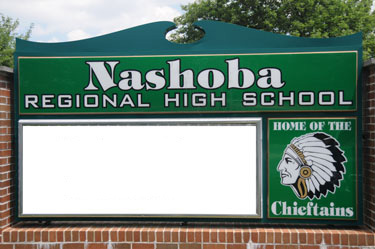
The topic of the evening was not at the top of the Nashoba School Committee’s agenda last night, but that did not stop it from dominating the meeting for more than an hour. “We think we know why many of you are here,” Committee Co-Chair Nancy Federspiel of Bolton announced to about 25 audience members. “But this is not a School Committee issue, it’s an issue for the high school.”
Federspiel was referring to the question among many Nashoba Regional High School parents as to why three of the school’s students — awaiting trial on crimes ranging from armed robbery to assault with a dangerous weapon — are reported to be attending classes. Stow’s Zachary Gross, 18, and Lucas Estabrook, both 17, along with an unnamed 16-year-old Bolton student, were allegedly involved in a Sudbury drug deal gone awry in July. Gross’s movements are being monitored by a GPS-enabled ankle bracelet, and he is allowed to leave home only under limited circumstances, including to attend school.
Though NRHS has allowed the students to continue attending school, the Sudbury students also allegedly involved in the incident were not allowed to return to Lincoln-Sudbury Regional High School.
Meanwhile, attendees at last night’s Committee meeting denounced Nashoba’s decision to allow the students to attend classes. But first, Superintendent Michael Wood assured that the students did not pose a threat to other students and staff.
“Our job is to make sure our kids are safe, above and beyond our mission,” said Wood. “But legal counsel advised that the principal has to decide what’s best for the individual.”
NRHS Principal Dr. Parry Graham stressed several times that he based the decision to allow the students to stay on state law, which declares that the principal must decide if the students are having a “substantial disruptive effect” on learning.
“This is one of the most difficult decisions I have ever had to make as an educator. It wakes me up in the middle of the night,” Graham said. “I don’t want your sympathy, and I’m still convinced we have a very safe environment.”
Asked what he would perceive to be a substantial disruptive effect, Graham outlined a situation where one student assaults another from a rival gang over a weekend. Though that is an unlikely scenario for NRHS, Graham pointed out that it is one where students from different gangs would have reason to feel threatened with retaliations if the assailant showed up at school Monday morning.
In outlining the security measures in place for the three students, Wood said the school maintains the right to search the students on entering school in the morning, and to assure they are not carrying weapons at any point throughout the day. They also are being closely monitored by staff and security cameras, with administration knowing where each one is at all times. However, Wood added that any other particulars of the plan need to be private for personal and safety reasons.
Graham remarked that NRHS has not yet conducted any bodily searches on the students. He was then questioned as to how the administration would know if someone smuggled the students any weapons during the school day. Graham assured that personal searches would be conducted soon.
As the audience continued to question what circumstances would prompt administration to remove the students, one parent asserted, “He was willing to point that gun at somebody’s head” [referring to the alleged actions of Gross]. That crosses a line for anyone in this room.”
Wood agreed that parents pulling students from the high school over their concerns could be a “piece of the puzzle.” He also mentioned that a number of students coming to guidance to voice any discomfort might fit the definition.
After another audience member cautioned that teenagers may be reluctant to report these fears or to perceive themselves in danger at all, NRHS Student Rep. Louis Bennett of Stow asserted, “90% of [the student body] does not care that much. They are innocent until proven guilty. If they are kicked out of school and found innocent, this will effect them for the rest of their lives.”
Reiterating that the School Committee cannot control this situation, Nancy Federspiel urged parents and administration to work out any solutions. Still, one parent remarked that, should anything happen with the alleged criminals at the high school, the legal and financial ramifications would come back to the Committee.
Elsewhere on the Agenda
In other issues on the agenda, the Committee voted unanimously to accept the district’s proposed 5-year strategic plan for shoring up the Media Centers throughout Nashoba’s schools. District Technology Integration Coordinator Cynthia Larsen outlined the extensive plan and its accent on making technology work better to bring all the district’s libraries together, and to make them more accessible to students.
With the substantial completion of the Center School project, the Pompositticut School was officially closed. The Committee voted unanimously both to close the school, and to notify Stow that Nashoba intends to terminate its lease of the building as of October 15.